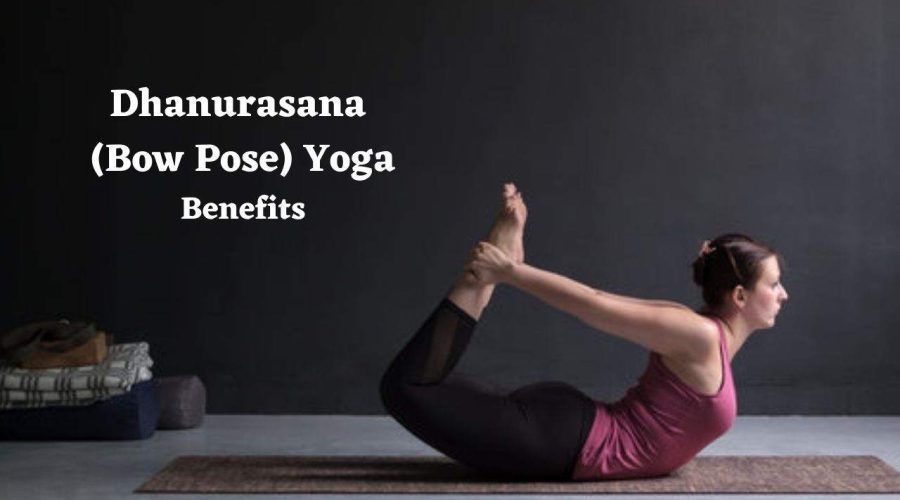Dhanurasana (Bow Pose) In Yoga: Know the Benefits, Steps and Precautions
Dhanurasana (bow stance) is one of the 12 basic hatha yoga poses. Urdva Chakrasana is the bow-like stance of an archer. In Sanskrit, the words “Dhanu” and “Asana” translate to “bow” and “posture,” respectively.
With a strong stretch across your front and a profound opening at your heart centre, this yoga position can help you build a courageous and elegant attitude. One of three back-stretching exercises is this one.
The Dhanurasana position in yoga stretches and stimulates virtually every major muscle group in the body, including the arms, shoulders, and back; biceps, triceps; core (abs), hamstrings; chest; hips; knee; and neck.
Types of Dhanurasana Yoga
Parsva Dhanurasana – In a prone posture, it is a back-bending stretching pose. The side bow pose, or flank bow pose, is another name for this pose. The body is rolled to the side to improve the stretching effect in this intermediate level pose.
Purna Dhanurasana – The entire body appears to be in the shape of a completely extended bow in this asana, a deep back-bend pose that opens your heart.
Steps to do Dhanurasana
- Lie down on your stomach, flat on your back.
- Make sure your head is resting against the floor and your legs are close together.
- Bring your feet up behind you and bend your legs at the knees.
- Backwards-stretch your arms and grab your ankles.
Inhale. Raise your head and your thighs off the ground at the same time. - Right now, your body should be arching upwards.
At the start, hold the position for 10 seconds. - You can gradually raise the timing to around one minute as you practise.
Benefits of Dhanurasana Yoga
The benefits of Dhanurasana yoga span from mental to physical well-being. Regular Dhanurasana practice has numerous health benefits.
- The abdomen and abdominal organs expand in this position, increasing reproductive activities.
- The ankles, thighs, groynes, chest, shoulders, neck, backbone, and abdominal muscles are all strengthened and stretched.
- Dhanurasana practice aids in calorie loss and body fat burning, particularly in the abdomen. It also assists in the toning of the legs and arms.
- It is especially effective for reducing tiredness and sluggishness.
- This asana strengthens the muscles around the navel, improving kidney and liver function, as well as the digestive and reproductive systems.
- It aids digestion and appetite as well.
- Dhanurasana is a yoga pose that increases blood circulation throughout the body and organs.
- It also helps those who have kidney stones, glomerulonephritis, kidney disorders, urinary tract infections (UTIs), and other kidney problems.
- Because it stretches the nerves, tendons, and ligaments in the back, Dhanurasana is a good asana for relieving back pain.
- This yoga pose stimulates the liver while also improving the function of other surrounding organs.
- The position of Dhanurasana is beneficial in the treatment of asthma.
- It may also help with cramps and constipation during menstruation.
- Gastritis (obesity), rheumatism, and digestive problems are all treated with it.
- It also helps with diabetes and improves pancreatic function.
Who Shouldn’t Practice Dhanurasana (Bow Pose)
Because the posture has such a powerful impact on the abdomen area, there are several restrictions on who should and shouldn’t execute it. If you have any of the following conditions, do not practise Dhanurasana (Bow Pose):
- High or low blood pressure, because this stance makes breathing difficult, reducing blood flow to the brain.
- HerniasInsomnia
- Injury to the neck
- Spondylitis
- Lower back pain or a back injury
- Migraine headache
- Ulcer in the stomach
- Abdominal surgery recently completed
This Dhanurasana pose is not recommended for pregnant women. Understanding the architecture of the body and the effects of various yoga poses is critical. If you are a complete newbie in yoga, do not perform Dhanurasana steps at home.
Frequently Asked Questions
1. What is the meaning of Dhanurasana?
Dhanurasana (bow stance) is one of the 12 basic hatha yoga poses. Urdva Chakrasana is the bow-like stance of an archer. In Sanskrit, the words “Dhanu” and “Asana” translate to “bow” and “posture,” respectively.
2. What is the benefit of Dhanurasana?
Here are some of the ways that Dhanurasana might help you. Stretches the abdominal muscles while also aiding digestion. The strength of your ankles, legs, chest, neck, and shoulders is improved. It aids in the toning of your abdominal region. Improves spinal flexibility and tones your back.
3. Can Dhanurasana reduce belly fat?
Pose of the Bow (Dhanurasana) This asana aids in the reduction of belly fat and is helpful for reducing waist fat. Your abdomen will be toned as a result of this position. It also gives the back, thighs, arms, and chest a wonderful stretch.
4. What is the counter pose of dhanurasana?
Slowly lower your torso and knees, release your hands, and bring your legs to the ground to exit Dhanurasana. Balasana, also known as Child’s Pose, is a terrific counter pose to Dhanurasana that helps to alleviate compression in the lower back.

